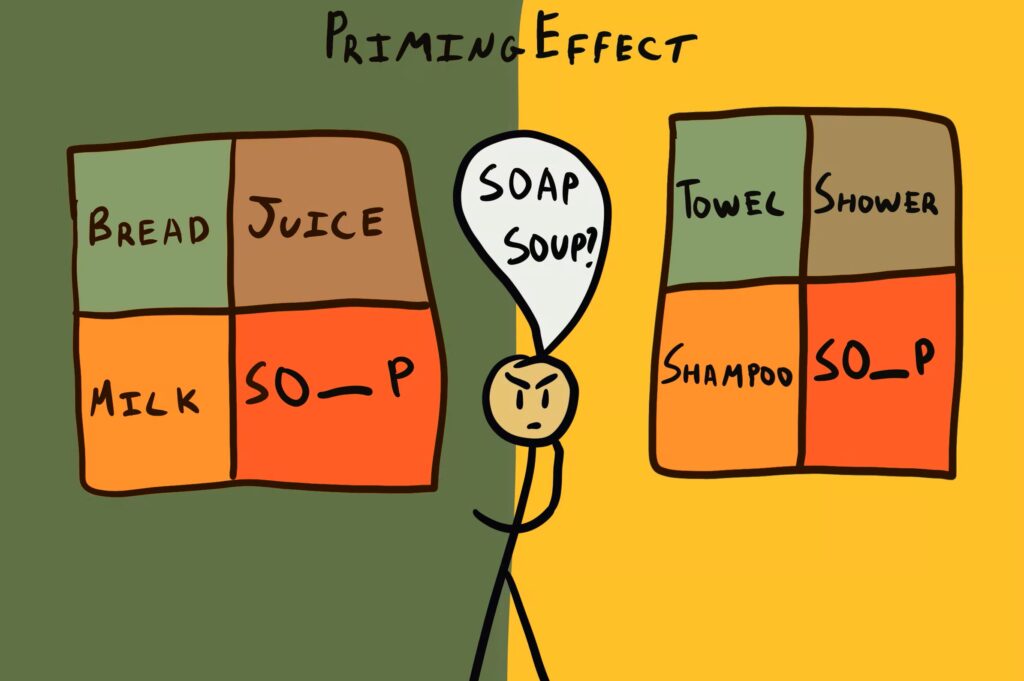
What is Priming?
Priming is a psychological technique whereby exposure to a certain stimulus may influence the response to a subsequent stimulus. North et al (1999)[1] investigated the extent to which stereotypically French and German music could influence supermarket customers selecting of French and German wines.
Over a two-week period, French and German music was played on alternate days from an in-store display of French and German wines. French music led to French wines outselling German wines, whereas German music led to German wines outselling French wines.
Responses to a questionnaire suggested that customers were unaware of these effects of music on their product choices.

Figure 13: the results derived by North et al, with French music positively impacting the purchase of French wine and German music positively impacting the purchase of German wine. Adapted from findings within ‘The influence of in-store music on wine selections’ by A.C North et al, 1999.[2]
Effects of Priming
Priming can have different effects on different people. A study by Rick et al (2008)[3] tested the effect of priming on subjects who experienced different levels of anticipatory mental pain when paying for products (‘Spendthrifts’, who experience low pain vs ‘Tightwads’, who experience high pain).
When primed with sad music, the Spendthrifts indicated they would spend more, while the Tightwads indicated they would spend less. Both strategies aimed to make them feel better: Spendthrifts cheered themselves up by going shopping, while Tightwads made themselves feel more in control by managing their budget. This provides some evidence for the need for segmentation strategies when utilising these types of approaches.
For loyalty programs, understanding whether members respond better to bonus earn promotions, bonus redemption promotions or discount offers will increase the effectiveness of priming members to take a desired action. For example, informing the member they will earn bonus points for a transaction may act to reduce the mental pain of the member spending money.
Another application of priming is the use of status tier labels invoking value (e.g., Gold, Platinum, Emerald and Diamond). Drèze and Nunes (2009)[4] found that using status-laden colours (Gold and Silver) primed members to form a perception of a pyramid-shaped hierarchy without them needing to specify the percentage of customers in each tier. This was not the case when the colours Blue and Yellow were used.
Applications of Priming
Product placement within physical supermarkets is a primary driver for influencing purchase behaviours, and Everyday Rewards have found a way to deliver the same effects digitally by priming their member base.
Woolworths prime their program members to try new products that they usually would not purchase by strategically placing them alongside commonly purchased products within personalised emails. In this way, members become familiar with products that they have never even considered.
As an example of the type of insight they have learned and applied to grow member spend, Everyday Rewards identified that ‘new products sandwiched between familiar products or brands are more likely to be bought and tried by consumers’.[5]
[1] North, A. C., Hargreaves, D. J. & McKendrick, J., 1999, ‘The influence of in-store music on wine selections.’ Journal of Applied Psychology, Vol 84, Iss 2, pp271-276.
[2] North, A. C., Hargreaves, D. J. & McKendrick, J., 1999, ‘The influence of in-store music on wine selections.’ Journal of Applied Psychology, Vol 84, Iss 2, pp271-276.
[3] Rick, S. I., Cryder, C. E. & Loewenstein, G., 2008, ‘Tightwads and spendthrifts’, Journal of Consumer Research, Vol 34, Iss 6, pp767–782.
[4] Drèze, X. & Nunes, J., 2009, ‘Feeling Superior: The Impact of Loyalty Program Structure on Consumers’ Perceptions of Status’, Journal of Consumer Research, Vol 35, pp890-905.
[5] Maes, I., cited in Croft, L., 2018, ‘We must treat data as a precious gift’, says Woolies Exec’, http://www.bandt.com.au/marketing/must-treat-data-precious-gift-says-woolies-exec, accessed 10th April 2019.

